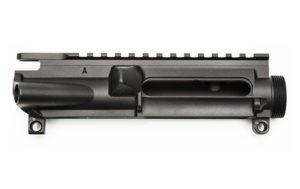 –Coating Description — Type III the temperature of the sulfuric acid must be reduced to 0 °C / 32 °F. This allows the anodizing to build to a heavier thickness (MIL-Standard). The anodizing voltage is also increased to 50-90 volts (depending on the type of aluminum being used) this is a very hard and highly wear-resistant coating. It is possible to achieve a .002″ thickness with a 50% Penetration and 50% Buildup on the surface. This is called “hard coat” or “hard anodizing”. Type III is primarily used on items such as machine parts, automobile components, down hole tools, and firearms. Due to the thickness of type III most hard coat coatings finish with a gray to charcoal color. Hard coated parts are rarely dyed bright colors, because the colors typically take unevenly. They can however be dyed dark tones when necessary and black mainly.
–Coating Description — Type III the temperature of the sulfuric acid must be reduced to 0 °C / 32 °F. This allows the anodizing to build to a heavier thickness (MIL-Standard). The anodizing voltage is also increased to 50-90 volts (depending on the type of aluminum being used) this is a very hard and highly wear-resistant coating. It is possible to achieve a .002″ thickness with a 50% Penetration and 50% Buildup on the surface. This is called “hard coat” or “hard anodizing”. Type III is primarily used on items such as machine parts, automobile components, down hole tools, and firearms. Due to the thickness of type III most hard coat coatings finish with a gray to charcoal color. Hard coated parts are rarely dyed bright colors, because the colors typically take unevenly. They can however be dyed dark tones when necessary and black mainly.
–Process Description — a protective oxide layer by an electrolytic process in which the metal forms the anode coating. Anodizing involves placing aluminum into a chemical acid bath charged with a DC current. The aluminum becomes the positive anode (which the term “anodizing” originates) of a chemical battery and the acid bath becomes the negative. The DC electric current passing through the acid causes the release of hydrogen at the negative electrode (cathode) and oxygen at the surface of the aluminum object creates a buildup of aluminum oxide. This oxidation forms a strong coating as it replaces the original aluminum surface. The typical anodizing process is multi step, and includes pretreatment steps before anodizing and post-treatments sealing and dying it after.
